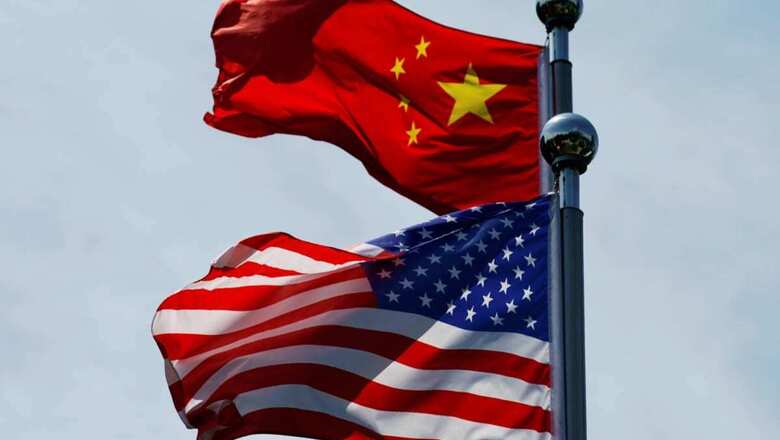
views
Military activity in the South China Sea spiked over the weekend as a Chinese aircraft carrier entered the region and a US Navy expeditionary strike group wrapped up exercises.
Meanwhile, the US and Philippines were preparing for joint drills as the US secretary of defense proposed ways to deepen military cooperation between Washington and Manila after China massed vessels in disputed waters.
China’s state-run Global Times on Sunday said the country’s first aircraft carrier, the Liaoning, steamed into the South China Sea on Saturday after completing a week of naval exercises around Taiwan. There was no official announcement of the Liaoning’s position, but the Chinese tabloid cited satellite images first reported by US media outlet The War Zone.
US Navy Cmdr. Robert Briggs and Cmdr. Richard Slye monitor the Chinese aircraft carrier Liaoning from the pilothouse of the guided-missile destroyer USS Mustin on April 4.
The Liaoning’s reported arrival in the South China Sea came after a US Navy expeditionary strike group, fronted by the aircraft carrier USS Theodore Roosevelt and amphibious assault ship USS Makin Island, conducted exercises in the South China Sea a day earlier. The two flat-top warships were joined by a cruiser, destroyers and smaller amphibious ships.
The ships also carried hundreds of Marine ground forces from the 15th Marine Expeditionary Unit as well as their supporting helicopters and F-35 fighter jets.
“This expeditionary strike force fully demonstrates that we maintain a combat-credible force, capable of responding to any contingency, deter aggression, and provide regional security and stability in support of a free and open Indo-Pacific,” US Navy Capt. Stewart Bateshansky, commodore, Amphibious Squadron 3, said in a statement.
Global Times quoted a Chinese military expert, Wei Dongxu, as saying the US Navy exercises were a provocation.
Exercises by the Chinese carrier “can establish wider maritime defensive positions, safeguard China’s coastal regions, and keep US military activities in check,” the report said, citing Wei.
But a US analyst described the Liaoning’s presence in the South China Sea as normal for the spring when weather conditions are conducive to training. “The Liaoning goes down there this time of year (to practice) air defense and live-fire training,” said Carl Schuster, a former director of operations at the US Pacific Command’s Joint Intelligence Center.
US-Philippines joint exercises
On Monday, more than 1,700 US and Philippines troops were beginning two weeks of military exercises, Reuters reported, citing Philippine military chief Lt. Gen. Cirilito Sobejana.
The drills will focus on testing the readiness of US and Philippine troops to respond to events such as extremist attacks and natural disasters, the report said.
They come after US Defense Secretary Lloyd Austin on Sunday proposed to his counterpart in Manila, Delfin Lorenzana, ways to deepen ties between the US and Philippine militaries, a Pentagon statement said.
The proposals included ways of “enhancing situational awareness of threats in the South China Sea” and come after “the recent massing of People’s Republic of China maritime militia vessels at Whitsun Reef,” in the Philippines’ exclusive economic zone in the Spratly Islands, the statement said.
Washington and Manila are tied by a mutual defense treaty, which officials said could come into play in the event of any Chinese military action against Philippine government vessels around Whitsun Reef.
Philippine Foreign Secretary Teodoro Locsin Jr. on Saturday tweeted he will work to have any attack on Philippine civilian craft trigger mutual defense aid, CNN Philippines reported.
Locsin’s comments came after a Filipino news crew said last week their chartered boat was chased down by Chinese missile boats as it approached a disputed shoal in the Spratly chain, according to the CNN Philippines report.
China claims almost all of the 1.3 million square mile South China Sea as its sovereign territory, running up against claims from the Philippines and other nations. In recent years, Beijing has turned disputed features in the region into man-made islands, complete with military fortifications.
Beijing accuses Washington and other foreign navies of stoking tensions in the region by sending in warships like the current expeditionary group led by the carrier Roosevelt.
Taiwan tensions
Tensions extend to the northeastern edges of the South China Sea, where the island of Taiwan sits. Beijing claims the democratic, self-governed island of almost 24 million people as its territory, even though the two sides have been governed separately for more than seven decades.
Chinese President Xi Jinping has vowed that Beijing will never allow Taiwan to become formally independent and has refused to rule out the use of force, if necessary, to unify the island with the mainland.
Before moving into the South China Sea at the weekend, the Chinese aircraft carrier Liaoning had been putting on a show of military muscle around Taiwan for a week, according to Chinese state media. At one point the People’s Liberation Army flanked Taiwan, with the Liaoning and its escorts operating in the Pacific Ocean to the east and PLA warplanes making forays into Taiwan’s self-declared air defense identification zone to the west.
Analysts said the exercises were a warning to Taipei and Washington that Beijing would not brook any moves for Taiwanese independence and was prepared to act militarily to prevent that from happening.
US Secretary of State Antony Blinken on Sunday said Washington was standing by a commitment to defend Taiwan.
“What is a real concern to us is increasingly aggressive actions by the government in Beijing directed at Taiwan,” Blinken said on NBC’s “Meet the Press.”
“We have a serious commitment to Taiwan being able to defend itself. We have a serious commitment to peace and security in the Western Pacific. And in that context, it would be a serious mistake for anyone to try to change that status quo by force,” Blinken said.
Read all the Latest News, Breaking News and Coronavirus News here. Follow us on Facebook, Twitter and Telegram.

















Comments
0 comment